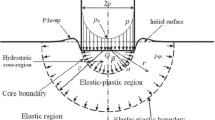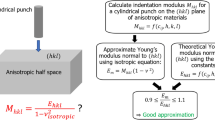Abstract
The finite element method is used to investigate the indentation behavior of two-dimensional (2D) materials mounted on a substrate. The overall indentation response of the composite structure of 2D-material/substrate is highly sensitive to the elastic modulus ratio of the 2D-material to its substrate (\(\lambda \)). When \(\lambda \) is small (e.g., \(\lambda < 100\)), the overall indentation load–displacement relationship agrees with the classic indentation model (e.g., the Hertz model), whereas with a large \(\lambda \) (e.g., \(\lambda \ge 10^{3}\)), the indentation behavior of the composite structure will deviate from the manner predicted by the classic indentation model. In addition, with a small \(\lambda \), the overall indentation modulus of the composite structure is very close to that of the pure substrate (i.e., the 2D-material has a very weak contribution to the overall indentation modulus), and thus, the elastic modulus of the 2D-material cannot be effectively determined from the overall indentation modulus. The contribution of the 2D-material rapidly increases with \(\lambda \), and when \(\lambda > 10^{4}\), it is possible to accurately determine the elastic modulus of the 2D-material from the overall indentation response by the inverse analysis.
Similar content being viewed by others
References
Geim, A.K., Novoselov, K.S.: The rise of graphene. Nat. Mater. 6(3), 183–191 (2007)
Novoselov, K.S., et al.: Two-dimensional gas of massless Dirac fermions in graphene. Nature 438(7065), 197–200 (2005)
Eda, G., Fanchini, G., Chhowalla, M.: Large-area ultrathin films of reduced graphene oxide as a transparent and flexible electronic material. Nat. Nanotechnol. 3(5), 270–274 (2008)
Papageorgiou, D.G., Kinloch, I.A., Young, R.J.: Graphene/elastomer nanocomposites. Carbon 95, 460–484 (2015)
Ho, D.H., et al.: Stretchable and multimodal all graphene electronic skin. Adv. Mater. 28(13), 2601 (2016)
Wang, Q.H., et al.: Electronics and optoelectronics of two-dimensional transition metal dichalcogenides. Nat. Nanotechnol. 7(11), 699–712 (2012)
Georgiou, T., et al.: Vertical field-effect transistor based on graphene-WS2 heterostructures for flexible and transparent electronics. Nat. Nanotechnol. 8(2), 100–103 (2013)
Yin, Z.Y., et al.: Organic photovoltaic devices using highly flexible reduced graphene oxide films as transparent electrodes. Acs Nano 4(9), 5263–5268 (2010)
Lahiri, I., Verma, V.P., Choi, W.: An all-graphene based transparent and flexible field emission device. Carbon 49(5), 1614–1619 (2011)
Hou, C.Y., et al.: Highly conductive, flexible, and compressible all-graphene passive electronic skin for sensing human touch. Adv. Mater. 26(29), 5018–5024 (2014)
Lee, C., Wei, X.D., Kysar, J.W., Hone, J.: Measurement of the elastic properties and intrinsic strength of monolayer graphene. Science 321(5887), 385–388 (2008)
Jiang, T., Huang, R., Zhu, Y.: Interfacial sliding and buckling of monolayer graphene on a stretchable substrate. Adv. Funct. Mater. 24(3), 396–402 (2014)
Chen, J., et al.: Nanomechanical properties of graphene on poly(ethylene terephthalate) substrate. Carbon 55, 144–150 (2013)
Zhang, Y.P., Pan, C.X.: Measurements of mechanical properties and number of layers of graphene from nano-indentation. Diam. Relat. Mater. 24, 1–5 (2012)
Oliver, W.C., Pharr, G.M.: Measurement of hardness and elastic modulus by instrumented indentation: advances in understanding and refinements to methodology. J. Mater. Res. 19(1), 3–20 (2004)
Chen, S.H., Liu, L., Wang, T.C.: Investigation of the mechanical properties of thin films by nanoindentation, considering the effects of thickness and different coating-substrate combinations. Surf. Coat. Technol. 191(1), 25–32 (2005)
Niu, T.X., Cao, G.X., Xiong, C.Y.: Fracture behavior of graphene mounted on stretchable substrate. Carbon 109, 852–859 (2016)
Wei, Y.J., et al.: Bending rigidity and Gaussian bending stiffness of single-layered graphene. Nano Lett. 13(1), 26–30 (2013)
Bunch, J.S., et al.: Impermeable atomic membranes from graphene sheets. Nano Lett. 8(8), 2458–2462 (2008)
Zhou, L.X., Xue, J.M., Wang, Y.G., Cao, G.X.: Molecular mechanics simulations of the deformation mechanism of graphene monolayer under free standing indentation. Carbon 63, 117–124 (2013)
Zhou, L.X., Wang, Y.G., Cao, G.X.: van der Waals effect on the nanoindentation response of free standing monolayer graphene. Carbon 57, 357–362 (2013)
Zhou, L.X., Wang, Y.G., Cao, G.X.: Boundary condition and pre-strain effects on the free standing indentation response of graphene monolayer. J. Phys. Condens. Matter 25(47), 475303 (2013)
Cao, G.X.: Atomistic studies of mechanical properties of graphene. Polymers 6(9), 2404–2432 (2014)
Wei, Q., Peng, X.H.: Superior mechanical flexibility of phosphorene and few-layer black phosphorus. Appl. Phys. Lett. 104(25), 251915 (2014)
Xiong, S., Cao, G.X.: Molecular dynamics simulations of mechanical properties of monolayer \(MoS_{2}\). Nanotechnology 26(18), 185705 (2015)
Johnston, I.D., McCluskey, D.K., Tan, C.K.L., Tracey, M.C.: Mechanical characterization of bulk Sylgard 184 for microfluidics and microengineering. J. Micromech. Microeng. 24(3), 035017 (2014)
Johnson, K.L.: Contact Mechanics. Cambridge University Press, Cambridge (1985)
Cao, G., Chandra, N.: Evaluation of biological cell properties using dynamic indentation measurement. Phys. Rev. E 81(2), 021924 (2010)
Cao, G., Sui, J., Sun, S.: Evaluating the nucleus effect on the dynamic indentation behavior of cells. Biomech. Modeling Mechanobiol. 12(1), 55–66 (2013)
Niu, T., Cao, G.: Finite size effect does not depend on the loading history in soft matter indentation. J. Phys. D Appl. Phys. 47(38), 385303 (2014)
Niu, T., Cao, G.: Power-law rheology characterization of biological cell properties under AFM indentation measurement. RSC Adv. 4(55), 29291–29299 (2014)
Cao, G.X., Chen, X., Xu, Z.H., Li, X.D.: Measuring mechanical properties of micro- and nano-fibers embedded in an elastic substrate: theoretical framework and experiment. Compos. Part B Eng. 41(1), 33–41 (2010)
Zhao, M., et al.: Measuring elastoplastic properties of thin films on an elastic substrate using sharp indentation. Acta Mater. 55(18), 6260–6274 (2007)
Author information
Authors and Affiliations
Corresponding author
Rights and permissions
About this article
Cite this article
Cao, G., Niu, T. Finite element modeling of the indentation behavior of two-dimensional materials. Acta Mech 230, 1367–1376 (2019). https://doi.org/10.1007/s00707-017-2020-3
Received:
Published:
Issue Date:
DOI: https://doi.org/10.1007/s00707-017-2020-3




